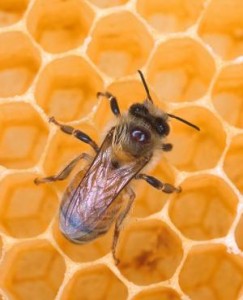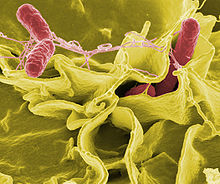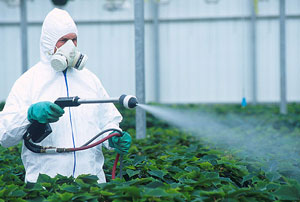 At the grocery store or in the news, you’ve likely come across the controversy over products made with genetically-modified organisms, or GMOs. Scientific advances that use biotechnology to create plants that can resist disease and insects, offer higher yields and include additional nutrients have sparked fear among the public. The worry is that that genetically-modified foods will harm human health and the environment. [Read more…]
At the grocery store or in the news, you’ve likely come across the controversy over products made with genetically-modified organisms, or GMOs. Scientific advances that use biotechnology to create plants that can resist disease and insects, offer higher yields and include additional nutrients have sparked fear among the public. The worry is that that genetically-modified foods will harm human health and the environment. [Read more…]
GMOs: Agricultural improvement or health threat?
The evidence on arsenic and rice
 The magazine Consumer Reports released a study last month that revealed low levels of arsenic – a chemical element that is toxic when consumed in higher doses – in rice and rice products grown across the world.
The magazine Consumer Reports released a study last month that revealed low levels of arsenic – a chemical element that is toxic when consumed in higher doses – in rice and rice products grown across the world.
The study tested 223 types of rice and rice products – such as rice-based cereals and rice milk – purchased in the United States in April, May and August of this year. It found arsenic in every product it tested, and dangerous levels of inorganic arsenic in dozens of products. Consumer Reports the story points out that their study is “a spot check of the market and “too limited to offer general conclusions about arsenic levels in specific brands within/across rice product categories.” Nevertheless, their article raises some surprising questions about toxins in our food supply.
Following the Consumer Reports study, the U.S. Food and Drug Administration released some preliminary results of a long-term study on arsenic levels in our food supply. Their study found levels of arsenic in rice similar to the Consumer Reports study.
So, what’s a rice-lover to do? Consumer Reports recommends limiting consumption of rice and rice products, while the FDA is not recommending any limits on rice consumption.
Since the FDA and Consumers Reports found the same level of arsenic in food, the question in my mind is: Exactly how dangerous is low-level exposure to arsenic? A search of systematic reviews yielded some interesting results.
- One meta-analysis found consuming arsenic in drinking water is associated with a higher risk of lung cancer.
- Another analysis found chronic arsenic exposure can lead to mental retardation and developmental disabilities such as physical, cognitive, psychological, sensory and speech impairments – although in higher levels that measured in the rice products tested by Consumer Reports and the FDA.
- Other analyses found inconclusive results on the relationship between arsenic exposure and diabetes and arsenic exposure and cardiovascular disease – although both of these reviews identified limitations in the study methodology and called for additional research.
My plan is to think more carefully about the rice products my family consumes. I’m not going to throw out the brown rice in my pantry, and we will still enjoy stir fry and sushi on a regular basis. But I certainly plan to steer way from rice cereals and other rice products at the grocery store.
More evidence: Pesticides and Parkinson’s disease
The brain is the most complex organ in the human body responsible for our movement, behavior and personality. Medical conditions that originate in the brain are some of the most difficult to understand and treat. Among these conditions in Parkinson’s disease, a degenerative disorder that includes symptoms of shaking, rigidity, difficulty walking, as well as cognitive and behavioral problems.
The review analyzed 45 different studies looked pesticide exposure and risk for disease. It found that people exposed specifically to herbicides and insecticides were more likely to develop Parkinson’s disease.
Interestingly, the review also found that it didn’t matter whether participants were exposed to pesticides at work, or outside of work – the risk for developing Parkinson’s disease was approximately the same.
At the end of the review, the authors call for more research to help identify specifically which chemicals are linked to the disease.
As I type this, I look out at my lawn that has more than its fair share of weeds growing in it. But I’m happy that we chose all-natural, corn-based fertilizer’s this year. We’re surely going to be pulling more weeds than if we used stronger herbicides, but I’m happy to avoid anything that could impact my family’s health in the future.
The facts on honey
 It’s sticky, it’s sweet and it tastes wonderful on a warm biscuit. Honey is a natural sweeter that’s been that provides a natural form of instant energy. And it’s been used for centuries as an antibacterial agent.
It’s sticky, it’s sweet and it tastes wonderful on a warm biscuit. Honey is a natural sweeter that’s been that provides a natural form of instant energy. And it’s been used for centuries as an antibacterial agent.
Now new evidence from the Food Safety News shows that the majority of honey available in U.S. grocery stores is missing the pollen, which would lead it to fail quality standards set by many of the world’s food safety agencies.
The pollen in honey serves several purposes. It provides some nutritional benefits, it is thought to help minimize seasonal allergies, and it helps food safety officials track where the honey is from.
The pollen is removed from honey using a technique called ultra filtering, where honey is heated, sometimes watered down and then forced at high pressure through extremely small filters to remove pollen.
There’s no way to tell whether ultra-filtered honey is coming from an unsafe source. In the past, some imported honey was found to contain high levels of antibiotics and heavy metals.
The take-home message: Do your best to buy honey from a known local source, such as a farmer’s market or cooperative grocery store.
As a sidenote, Cornell happens to be one of the nation’s leading resources for information about honey bees. It houses the largest and most comprehensive apiculture library in the world as well as the Dyce Laboratory for Honey Bee Studies.
Wash your hands! And other ways to ward off food poisoning
 Following last week’s recall of 36 million pounds of ground turkey, we thought it’d be a good time to review the evidence on Salmonella poisoning.
Following last week’s recall of 36 million pounds of ground turkey, we thought it’d be a good time to review the evidence on Salmonella poisoning.
According to the U.S. Centers for Disease Control, the bacteria Salmonella live in the intestinal tracts of humans and other animals, including birds. People usually contract the bacteria by eating foods contaminated with animal feces, which typically look and smell normal even though they are carrying the bacteria. Salmonella is also be found in the feces of pets, especially, reptiles and young birds.
An estimated 1.4 million people contract Samonella poisoning every year in the U.S. A total of 107 cases in 31 states have been identified in the most recent outbreak spread by the ground turkey meat. Infection typically results in diarrhea, fever, and abdominal cramps 12 to 72 hours contact with the bacteria. The illness usually runs its course in 4 to 7 days, and most people don’t require treatment. But severe cases require hospitalization for dehydration.
So what’s the best way to prevent the spread of Samonella? The evidence shows there are some simple steps you can take to reduce your risk of Samonella poisoning.
- Cook poultry, ground beef, and eggs thoroughly.
- Wash hands, kitchen work surfaces, and utensils with soap and water immediately after they have been in contact with raw meat or poultry.
- Wash hands with soap after handling reptiles, birds, or baby chicks, and after contact with pet feces.
- Avoid direct or even indirect contact between reptiles and infants or immunocompromised persons.
Beyond these common-sense measures, researchers at Cornell are trying to do more. Two Cornell faculty members recently received a grant from the U.S. Department of Agriculture to study how tomato plants interact with the Samonella bacteria, with the hopes of eventually breeding new varieties of produce that suppress Samonella.
Until then, keep up the hand-washing!
Canning food at home: The best evidence-based advice
My Pennsylvania Dutch grandmother had an expression: “Eat what you can, and what you can’t – can!”
Okay, take a minute to think about it…
Like many Americans of her generation, she grew up with a kitchen garden, and a major family activity was preserving the summer’s bounty to liven up their diet during the winter. For many people today, canning food is an enjoyable activity and allows them to “eat locally” all winter long. Many people are joining CSAs (community supported agriculture), buying memberships that allow them weekly “shares” of a local farms produce, and preserving some of that food.
Sounds good, right? But a national survey found that many people who process food at home are doing it in a way that puts them at risk for spoiled food and foodborne illness. What’s an avid canner to do?
In steps the National Center for Home Food Processing and Preservation! This wonderful site, supported by the national Cooperative Extension system, has plenty of evidence-based advice for anyone interested in canning food that is delicious – and safe.
What will you find there? Just take a look at the Center’s list of “Seasonal Hot Topics”:
- If you are a home canner, this is the time of year to plan ahead and prepare. Get your equipment and supplies out and inspect them so you are ready when the crops are.
- Many quick pickle recipes call for small, pickling varieties of cucumbers. If these interest you, be prepared by looking ahead to know what kind of cucumbers are needed for your favorite.
- Ready to tackle your food cupboards during spring cleaning? Consult a food storage chart to see when it might be time to throw out some staples and start fresh.
Click on the links for more information. The last item is one that we have many arguments about in my household, with me wanting to throw out anything more than a week old. Who knew that you could keep an open box of cereal for 2-3 months?
And who can resist articles (all based firmly in scientific evidence) on topics like: “Pickling: Not Just for Cucumbers Anymore,” “What to Do if the Freezer Stops,” and “My Banana Chips Don’t Taste Like the Ones in Stores: What Can I do?”
There’s also a multi-media page, with videos of important home food preservation issues and slide shows, too. A tutorial about safe food preservation is a must for the novice, and it is really what this site is all about: preserving delicious food and using the latest scientific evidence to do it safely.
Happy canning!
Fairs and exhibitions: We love them in Cooperative Extension, but is there evidence?
I have always loved the county fair. So much so – yes, I’m going to admit it – that on the day after my wedding many years ago we took the entire gang to the the Lorain County Fair in Ohio. And Cooperative Extension staff and participants also enjoy county and state fairs – and devote considerable time throughout the year to planning and preparing for them.
So my interest was piqued by the title of a recent article in the Journal of Extension: “Fairs and other Exhibitions: Have We Really Thought this Through?” Author Donald Nicholson points out that the investment of effort and time by staff makes makes fairs the largest single program in Cooperative Extension. As he puts it: “There is no doubt that “The Fair” is deeply woven into the very DNA of Extension.” But that, he argues, keeps us from evaluating what we get from all the investment.
Nicholson asks: What do we actually know about whether participation in fairs actually promotes youth development?The answer, surprisingly, is that there is almost no scientific evidence of any kind on this topic. He notes that the public, and commodity groups. heavily support the fair, and that it is extremely popular among extension staff and program participants. But he poses a set of thought-provoking questions for state and county extension programs to consider:
- What is the 5-year or 10-year goal of Extension in regard to our role, goals, and mission with the fairs in your local or state Extension program?
- What is the research agenda and intention regarding fairs in your state?
- Are the procedures used and the time invested by Extension truly guided by research-based information?
- Could the same educational content be more effectively delivered in other ways with a similar or lesser investment of time and resources?
What is lacking is any solid research evidence regarding the benefits of fair activities to youth participants. Nicholson was able to identify only two pilot studies that addressed this issue. Given that fairs are probably the single biggest investment of extension, he argues for the development of a knowledge base on what youth development outcomes are achieved by fairs.
Very thought-provoking – as are the comments that follow the article. Some commenters agree with a closer examination of the effectiveness of fairs in extension, whereas others argue for the economic and public-relations benefits of the fair, regardless of scientifically-assessed outcomes.
Leave us a comment with your thoughts on this topic!
New federal diet guidelines follow the evidence
 Here at EBL, we’ve discussed how difficult it is to figure out what nutrition advice to follow, especially when there’s so much health and nutrition advice in the media that refers to anecdotes and simplistic inferences from single studies.
Here at EBL, we’ve discussed how difficult it is to figure out what nutrition advice to follow, especially when there’s so much health and nutrition advice in the media that refers to anecdotes and simplistic inferences from single studies.
For those looking for real evidence about what to eat, there’s some good news. The federal government has issued new dietary guidelines based on an extensive evidence-based review.
The U.S. Departments of Agriculture and Health and Human Services appointed 13 nationally-recognized experts in nutrition and health to review the scientific literature on how nutrition impacts health and disease prevention.
The experts worked with a new resource – USDA’s Nutrition Evidence Library, a clearinghouse of systematic reviews designed to inform federal nutrition policy. (You can read more about the process the panel used to create the new nutrition guidelines by clicking here.) The library employs post-graduate level researchers with experience in nutrition or public health to build its content. The researchers analyze peer-reviewed articles to build bodies of evidence, develop conclusion statements and describe research recommendations. It’s an EBL dream!
So what do the new guidelines recommend?
The entire report from the committee of experts is more than 400 pages long, with specific advice on everything from energy balances to food safety. Government officials distilled this report into 112 pages of dietary guidelines, and 23 recommendations for the general population. Among them are:
- Focus on consuming nutrient-dense foods and beverages.
- Reduce daily sodium intake to less than 2,300 milligrams (about 1 teaspoon).
- Limit the consumption of foods that contain refined grains, especially refined grain foods that contain solid fats, added sugars and sodium.
- Eat a variety of vegetables, especially dark-green and red and orange vegetables, and beans and peas.
- Consume at least half of all grains as whole grains. Increase whole-grain intake by replacing refined grains with whole grains.
- Increase the amount and variety of seafood consumed by choosing seafood in place of some meat and poultry.
As you can imagine, the EBL team is thrilled that the government is using systematic reviews to make national diet recommendations. They’re worth reading to see if you can improve your own diet. Even small changes can make a big difference when you consider the evidence.
The beginning of the end: The demise of cooperative extension in Canada
Cooperative Extension in the United States is a flagship program for connecting public “land-grant” universities to the general public. The goal of the Cooperative Extension System is to move knowledge created by researchers to groups who need it. A major audience has historically been agriculture, but other program areas deal with nutrition, child development, families, the environment and a variety of other issues.
I’ve worked as a faculty member in the Cooperative Extension program for 20 years, and I deeply admire the system. Like everyone with Extension responsibilities, I’ve been watching the changes that are going on nationally and at the state level. So I took notice of a very important cautionary note from our neighbors in Canada.
Writing in the Journal of Extension, Lee-Anne Milburn, Susan Mulley, and Carol Kline document the demise of agricultural extension in the province of Ontario. Their article, “The End of the Beginning and the Beginning of the End: The Decline of Public Agricultural Extension in Ontario,” shows how by the year 2000, “Extension in Ontario was moribund.”
How did this happen? According to Milburn and colleagues, some reasons are:
- The decline of people involved in farming; fewer than 2% of Canada’s population are now involved in agriculture.
- The decline in the agricultural sector in turn reduced political support for extension. Population changes “make agriculture less politically relevant and therefore create difficulties in accessing necessary funding for agricultural research and Extension.”
- A key point: Extension was unable to document economic benefits; without clear “return on investment,” the government was unwilling to fund it.
- Farmers now have access to many other information sources, making the Extension agent more of a “peer information consultant,” helping the farmer to access information rather than being seen as the source of expertise.
- Universities focus increasingly on scholarship; in the words of the authors this relegates “Extension to the academic hinterland of ‘service and outreach.’”
It’s clear that these issues confront Cooperative Extension in the United States. Fortunately, the authors have some suggestions for what people involved in Extension should do:
- Respond to the needs of rural non-farm residents. They point out that there are all kinds of issues in rural life Extension could respond to, like wetland and woodlot management, sustainable economic development, and conservation and stewardship.
- Recognize that Extension programs have a life cycle and redirect resources away from failing or outdated programs.
- Make creative use of new information technologies.
- And a very interesting point: They suggest that reducing Extension field staff can be a mistake, and replacing one-on-one contact with consumers “is a recipe for decline.” They recommend in-person training and discussions rather than fact sheets and web-based information alone.
All food for thought as we enter a new era in Cooperative Extension!
When every drop counts: The facts on public health during a drought
Throughout the history of the Earth, droughts spanning seasons or even years have taken their toll on plant and animal life. In more recent U.S. history, a series of major droughts every 20 to 30 years have devastated farms, sparked wildfires and led to adverse health effects.
Although the literature contains well-researched articles on the aspects and implications of drought itself, there have been few fact-based inquiries into how drought affects public health in the United States. Until recently.
Last month, the Centers for Disease Control and Prevention National Center for Environmental Health published a guide to assist public health officials to prepare for and cope with drought in their communities. The document includes information about how drought affects public health, recommends steps to help mitigate the health effects of drought and identifies future needs for research and other drought-related activities.
Among the CDC’s recommendations is to identify the populations that are most affected by a particular adverse condition. For instance, immune-compromised people drinking contaminated well water are most at risk of contracting infectious diseases. Once the affected populations have been identified, public health departments should actively collect and analyze quantitative and qualitative data to help determine the extent of the public health threat and the best steps to mitigate it.
The publication also suggests additional research in numerous areas including identifying the health effects of reusing water, using surveillance data to determine which chronic disease are more frequently reported during a drought, and identifying pathogens that can be used as drought indicators.
Intrigued? You can find the entire publication by clicking here.
Evidence-based cheese!
 It’s summer-time in the Finger Lakes – a great time of year to sample regional wines along one of the three local wine trails. On your tour this year, you can pair that wine with some delicious, local cheese.
It’s summer-time in the Finger Lakes – a great time of year to sample regional wines along one of the three local wine trails. On your tour this year, you can pair that wine with some delicious, local cheese.
Cornell Cooperative Extension has teamed up with regional cheese-makers to create the Finger Lakes Cheese Trail – a driving tour of local creameries where you can learn about the craft of cheese-making and sample local varieties including sheep’s milk cheese, goudas, goat cheese, cheddars, jacks, Colby and even cheese curds.
They’re absolutely delicious! But are they good for our diets?
The evidence says yes. In fact, cheese provides a myriad of health benefits. A single serving of cheese provides about 300 mg of calcium – nearly one-third of the daily recommended amount. And a study published in the American Journal of Clinical Nutrition demonstrated that getting calcium from cheese rather than supplements leads to improvements in bone density. Cheese packs in other key nutrients, too, including like protein, magnesium, folate, B1, B2, B6, B12, and vitamins A, D, and E.
Unfortunately, there’s a downside to cheese. Many cheeses are also high in cholesterol, sodium and saturated fat, which can contribute to obesity, high blood pressure, heart disease and cancer. But that doesn’t mean you should eliminate cheese from your diet.
Nutritionists at Yale-New Haven Hospital have published some guidelines on incorporating cheese in a healthy diet. Among their recommendations are:
- If you like to eat hard cheeses , look for “fat free,” “reduced fat” or “low fat” versions.
- When looking for soft cheeses, low fat , part-skim or light products are available.
- If you do use full-fat cheese in a recipe, cut the amount in half to reduce your fat and sodium intake.
So, go ahead. Melt some cheddar on that burger, sprinkle a bit of gorgonzola in your salad or visit a Finger Lakes creamery. As long as you indulge in moderation, you’ll reap all of the health benefits from cheese.
– Sheri Hall




